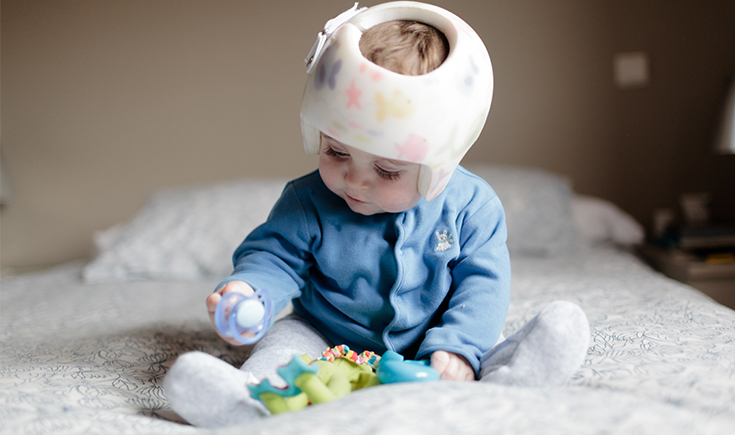

“Daddy, why is that baby wearing a watermelon on their head?”
Curiosity piqued, I turn around to see a young baby with a helmet on their head. Sure enough, it was designed with a pattern like a watermelon. I glance at the mother while she is holding her baby, and I see a mixture of emotions; sadness, embarrassment, but at the same time a degree of resilience.
“Sweetie” I say to my daughter, who was around four at the time, “this little baby has a particular condition where the shape of their skull is not quite round like how we expect most babies’ heads to be. So this brave mum has found a place that has been able to fit that special type of helmet for her baby that helps their head grow back into a more normal shape.”
“Oh. OK.”
The mum looks at me with appreciation in her eyes, and mouths a silent “thank you”.
Helmets are becoming more and more commonplace for the management of a particular skull condition known as plagiocephaly. And there is a simple reason for this; plagiocephaly is becoming more and more common. Over 15 years ago, we were looking at around 20% of babies under four months of age having changes to the normal shape of their heads.¹ Fast forward a few years, and we are now looking at nearly 50% experiencing the same problem at the same age.²
So what do the helmets actually do?
Well, there are two components that need to be addressed with plagiocephaly. Firstly, we are starting to get a much more profound understanding that children with changes to normal shape of their heads are at higher risk of neurodevelopmental delays.³⁻⁶ Secondly, there’s also the need to address the cosmetic changes that occur to the shape of the head itself. While there is mixed evidence regarding the neurodevelopmental benefits of helmet use, there is strong evidence supporting the use of helmets to help correct head shape.
But how do I know if my child needs to use a helmet?
Thankfully, there are many tools and measurements that are available to help us determine severity of the asymmetry occurring to your child’s head. The gold standard of the head asymmetry measurement involves measuring the two diagonals of your child’s head utilising a set of callipers and a special headband. Done correctly, this has been shown to be as accurate as a CT scan! Additionally, we can also utilise what is known as the Argenta classification, where we are able to look at visual differences to get an understanding of severity.⁷
Once we have determined all the values and severities, we then are greeted with a couple of options; if the child has a moderate to severe plagiocephaly present then helmet therapy may be required to assist in returning head shape back to a more normal shape. If the child is in that mild category, other options may be recommended; stretching, positioning, or even manual therapy such as that done by chiropractors, osteopaths or physiotherapists. The “fun” category are the children that fall within the mild to moderate range; they are not quite severe enough to start helmet therapy immediately, but may need it depending on how any other intervention progresses.
There are a couple of factors that may contribute to how this may progress. In a paper I had published in 2020, we found that restrictions in cervical spine or neck motion had a statistically significant association with developing plagiocephaly, suggesting the need to have your child’s musculoskeletal system assessed.⁸ The size of the anterior fontanelle, or the soft spot on top of your child’s head, has been linked to rate of progression suggesting the need to have any corrective therapy done at younger ages opposed to older ages when this closes up.⁹
If after this you still have some confusion regarding your child’s head shape or whether you need a helmet to use, I created a short video on YouTube that may be able to assist – https://youtu.be/KSoQOg3L5v4. Otherwise, be sure to talk to your health professional for more advice.























